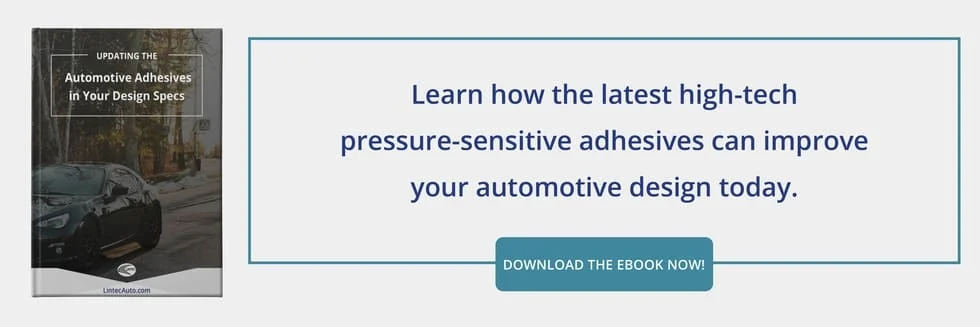6 Applications for Low VOC Adhesives in Automotive Designs

Low VOC adhesives are a special subset of automotive adhesives that are designed to limit the quantity of harmful chemicals released into the air when they are applied and also over time in the vehicle as they cure.
Increasing government regulations for IAQ (indoor air quality) in cars have led to tougher OEM standards for VOCs. Volatile organic compounds (VOCs), commonly off-gassed by thermoplastics, adhesives, sealants paints, and more substances, are known to have serious consequences for health and lead to respiratory problems. When released over time from common automotive adhesives, VOCs will react with sunlight and nitrogen oxides that are present in the air to create long-term health risks for assembly line workers or vehicle occupants.
What Counts as a VOC?
The EPA defines Volatile Organic Compounds (VOCs) as “any compound of carbon, excluding carbon monoxide, carbon dioxide, carbonic acid, metallic carbides or carbonates, and ammonium carbonate, which participates in atmospheric photochemical reactions.” National EPA regulations mandate VOC limits for a wide range of products, including the Control Technology Guideline (CTG) that helps states control VOC emissions from industrial adhesive applications such as in automobiles. You can read more about these regulations here.
Many automotive PSAs, tapes, and other adhesives—especially those used in the cabin—should feature a low volatile organic compound (VOC) makeup to keep automakers on the right side of the law.
Forms of Low VOC Adhesives
Markets and Markets has projected the low VOC adhesives market to reach $55.29 billion by 2022 with a healthy CAGR of 5.9%. Part of this robust growth can be attributed to the versatile formulations for low VOC adhesives, including:
- Water-based adhesives (natural or synthetic) that are activated when water evaporates from or is absorbed by a substrate.
- Hot melt adhesives that cure through the dissipation of heat.
- Reactive (or “solvent-based”) adhesives that often involve the combination of a monomer and an initiator to form an especially permanent bond.
6 Automotive Applications for Low VOC Adhesives
The most critical areas of the vehicle to consider using low VOC adhesives include:
- Automotive upholstery (leather, fabric, or synthetic)
- The bonding of composites and dissimilar substrates in the automotive cabin
- Decorative trim, emblems, data labels, stickers, finishing films, and other PSAs that are common throughout the vehicle
- Adhesives that are applied manually by manufacturing personnel
- Adhesives applied in a smaller, contained area within the factory
- PSAs that are backed with non-porous automotive films (to prevent bubbling or peeling)
Each of these six applications must consider not only the area and purpose of the adhesive, but the stresses that it will face over time in the vehicle. For example, high quality low VOC adhesives must be able to withstand extreme heat conditions if they are expected to perform in the engine compartment or in the automotive interior (where a sunny, 95-degree summer day is known to raise the average dashboard temperature to 157 degrees Fahrenheit). Ideally, your low VOC adhesives will reduce VOCs to stable levels—or eliminate them entirely—in all circumstances you could reasonably expect them to encounter.
Work With LINTEC Automotive For Low VOC Performance
LINTEC Automotive has been identified as a leading global automotive adhesive supplier, and for good reason. The expert team at LINTEC does not believe in compromising our products with substandard or cost-saving shortcuts.
You can trust our low VOC adhesives to provide lasting, eco-friendly performance with industrial-grade acrylics that will secure bond components without creating health repercussions for factory workers, drivers, or passengers. Contact us today for more information on how we can help you stay on the right side of low VOC regulations for automotive adhesives.


